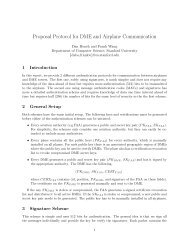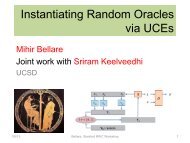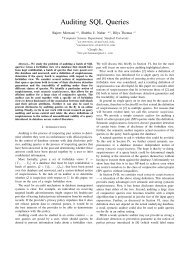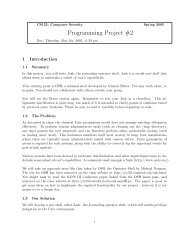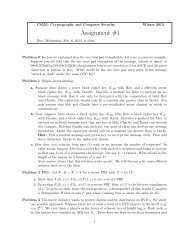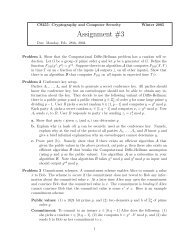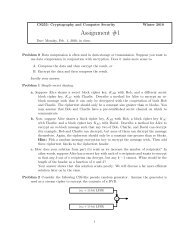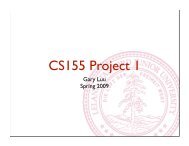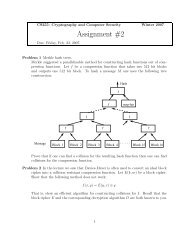Computing Arbitrary Functions of Encrypted Data - Stanford Crypto ...
Computing Arbitrary Functions of Encrypted Data - Stanford Crypto ...
Computing Arbitrary Functions of Encrypted Data - Stanford Crypto ...
You also want an ePaper? Increase the reach of your titles
YUMPU automatically turns print PDFs into web optimized ePapers that Google loves.
Recrypt E (pk 2, DE, sk1, c1).<br />
Generate c1 via Encrypt E(pk 2, c1j) over the bits <strong>of</strong> c1<br />
Output c ← EvaluateE(pk 2, DE, sk1, c1)<br />
The decryption circuit DE has input wires for the bits <strong>of</strong> a<br />
secret key and the bits <strong>of</strong> a ciphertext. Above, EvaluateE<br />
takes in the bits <strong>of</strong> sk1 and c1, each encrypted under pk 2.<br />
Then, E is used to evaluate the decryption circuit homomorphically.<br />
As long as E can handle DE, the output c is<br />
an encryption under pk 2 <strong>of</strong> Decrypt E (sk1, c1) = m. Recrypt E<br />
therefore outputs a new encryption <strong>of</strong> m, but under pk 2.<br />
One fascinating thing about Recrypt E is that the message<br />
m is doubly encrypted at one point, first under pk 1 and<br />
next under pk 2. Ordinarily, the only thing one can do with<br />
a doubly-encrypted message is to peel <strong>of</strong>f the outer encryption<br />
first, and then decrypt the inner layer. However, in<br />
Recrypt E , the EvaluateE algorithm is used to remove the inner<br />
encryption, just like Alice unlocks box #i while it is<br />
inside box #(i + 1).<br />
It is also useful to imagine that E is our somewhat homomorphic<br />
encryption scheme from Section 3, and consider<br />
what Recrypt E does to the noise <strong>of</strong> the ciphertexts. Evaluating<br />
DE removes the noise associated to the first ciphertext<br />
under pk 1 (because, <strong>of</strong> course, decryption removes noise),<br />
but EvaluateE simultaneously introduces new noise while<br />
evaluating the ciphertexts under pk 2. As long as the new<br />
noise added is less than the old noise removed, we have made<br />
“progress.” A similar situation holds in Alice’s jewelry store.<br />
When the worker extracts the piece from the used-up glovebox<br />
#i, this process simultaneously uses up the gloves <strong>of</strong> box<br />
#(i + 1). We have made “progress” as long as the process<br />
does not leave box #(i + 1)’s gloves completely used-up.<br />
Of course, our goal is to perform actual operations on<br />
underlying messages, not merely to obtain a new encryption<br />
<strong>of</strong> the same message. So, suppose that E can handle DE<br />
augmented by some gate – e.g., Add; call this augmented<br />
circuit DAdd. If c1 and c2 are two ciphertexts that encrypt<br />
m1 and m2, respectively, under pk 1, and we compute c1<br />
and c2 as before, as ciphertexts encrypting the bits <strong>of</strong> the<br />
ciphertexts under pk 2, then we have that<br />
c ← EvaluateE(pk 2, DAdd, sk1, c1, c2)<br />
is an encryption under pk 2 <strong>of</strong> m1 ⊕ m2.<br />
By recursing this process, we get a fully homomorphic encryption<br />
scheme. The public key in E † consists <strong>of</strong> a sequence<br />
<strong>of</strong> public keys (pk 1, . . . , pk ℓ+1) and a chain <strong>of</strong> encrypted secret<br />
keys sk1, . . . , skℓ, where ski is encrypted under pk i+1.<br />
To evaluate a function f in E † , we express f as a circuit,<br />
topologically arrange its gates into levels, and step through<br />
the levels sequentially. For a gate at level i + 1 (e.g., an Add<br />
gate), we take as input the encrypted secret key ski and a<br />
couple <strong>of</strong> ciphertexts associated to output wires at level i<br />
that are under pk i, and we homomorphically evaluate DAdd<br />
to get a ciphertext under pk i+1 associated to a wire at level<br />
i + 1. Finally, we output the ciphertext associated to the<br />
output wire <strong>of</strong> f.<br />
Putting the encrypted secret key bits sk1, . . . , skℓ in E † ’s<br />
public key is not a problem for security. These encrypted<br />
secret key bits are indistinguishable from encryptions <strong>of</strong> 0<br />
as long as E is semantically secure.<br />
4.4 Circular Security<br />
Strictly speaking, E † does not quite meet our definition<br />
<strong>of</strong> fully homomorphic encryption, since the complexity <strong>of</strong><br />
KeyGen E † grows linearly with the maximum circuit depth<br />
we want to evaluate. (Fortunately, Encrypt E † and Decrypt E †<br />
do not depend at all on the function f being evaluated.)<br />
However, suppose that E is not only bootstrappable, but<br />
also circular-secure – that is, it is “safe” to reveal the encryption<br />
<strong>of</strong> a secret key ski under its own associated public<br />
key pk i. Then, we can simplify KeyGen E †. We do not need<br />
distinct public keys pk i for each circuit level and an acyclic<br />
chain <strong>of</strong> encrypted secret keys. Instead, the public key in E †<br />
can consist merely <strong>of</strong> a single public key pk and a single encrypted<br />
secret key sk (sk under pk), where pk is associated<br />
to all levels <strong>of</strong> the circuit. This approach has the additional<br />
advantage that we do not need to decide beforehand the<br />
maximal circuit depth complexity <strong>of</strong> the functions that we<br />
want to be able to evaluate.<br />
For most encryption schemes, including our somewhat homomorphic<br />
scheme (as far as we know), revealing an encryption<br />
<strong>of</strong> sk under pk does not lead to any attack. However,<br />
it is typically difficult to prove that an encryption scheme is<br />
circular-secure.<br />
The issue <strong>of</strong> circular security also fits within our physical<br />
analogy. Suppose that a key is locked inside the very same<br />
box that the key could open from the outside. Is it possible<br />
to use the gloves and key to open the box from the inside? If<br />
so, it would be a strange lock. Similarly, encryption schemes<br />
that are insecure in this setting tend to be contrived.<br />
5. SOMEWHAT HOMOMORPHIC TO<br />
BOOTSTRAPPABLE<br />
Is our somewhat homomorphic encryption scheme from<br />
Section 3 already bootstrappable? Can it handle its own<br />
decryption circuit? Unfortunately, as far as we can tell,<br />
E can almost handle DE, but not quite. So, we modify<br />
E slightly, constructing a new (but closely related) somewhat<br />
homomorphic scheme E ∗ that can handle essentially<br />
the same functions that E can, but whose decryption circuit<br />
is simple enough to make E ∗ bootstrappable.<br />
5.1 Alice Gets Her Hands Dirty<br />
After her dream, Alice rushes to her store to see if her<br />
idea works. She locks box #1 and puts it inside box #2.<br />
Working with the gloves <strong>of</strong> box #2, she tries to unlock box<br />
#1 in less than one minute. The thickness <strong>of</strong> the gloves and<br />
the stickiness <strong>of</strong> the lock combine to make it impossible.<br />
She is despondent until she remembers that she has a<br />
special grease that makes her locks less sticky. This time,<br />
she locks box #3 and puts it inside box #4. She also puts<br />
her bottle <strong>of</strong> grease inside box #4. Working with the gloves<br />
<strong>of</strong> box #4, she squirts some grease on the lock and then tries<br />
to unlock it. But the gloves stiffen before she can finish.<br />
Then, she thinks: why didn’t I grease the box’s lock before<br />
putting it inside the other box? That way, I wouldn’t waste<br />
my valuable time with the gloves greasing the lock.<br />
She locks box #5, greases its lock, and then puts it inside<br />
box #6. Working with gloves, she tries the lock again. This<br />
time it works, despite the clumsiness <strong>of</strong> the gloves!<br />
At last, she has a system that lets her securely delegate<br />
the processing <strong>of</strong> her precious materials into arbitrarily complicated<br />
pieces! Her workers just need to apply the grease<br />
to each box before they put it inside the next box. She can



